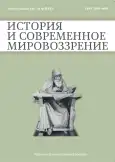Birthing Rites and Traditions of the Mordovian People: Past and Present
- Autores: Mokshina E.N.1, Narvatova M.A.1
-
Afiliações:
- Mordovian State University
- Edição: Volume 4, Nº 1 (2022)
- Páginas: 41-45
- Seção: Articles
- URL: https://journals.rcsi.science/2658-4654/article/view/147209
- ID: 147209
Citar
Texto integral
Resumo
Palavras-chave
Texto integral
##article.viewOnOriginalSite##Sobre autores
Elena Mokshina
Mordovian State University
Email: enm2112@mail.ru
Dr. Sci. (Hist.), Associate Professor of the Department of History of Russia Saransk, Russian Federation
Maria Narvatova
Mordovian State University
Email: aknarvatova@mail.ru
graduate student of the Department of History of Russia Saransk, Russian Federation
Bibliografia
- Balashov V. A. Domestic сulture of the Mordva. Traditions and мodernity. Saransk, 1992. 254 p.
- Belyaeva N. F. Traditional upbringing of children of the Mordva. Saransk, 2001. 260 p.
- Kandrina I. A. Folk knowledge and experience in childbirth rites of the Mordovian Republic // Bulletin of the TSTU. 2021. Р. 884-893.
- Kornishina G. A. Traditional customs and rituals of the Mordovians: historical roots, structure, forms of performance. Saransk, 2000. 150 p.
- Kornishina G. A. Traditional rite culture of the Mordovas. Saransk, 2007. 116 p.
- Luzgin A. С. In a close neighborhood: economy and material culture of Mordovia. Saransk, 1987. 188 p.
- Mokshin N. F. The secrets of Mordovian names: (Historical onomasticon of the Mordovian people). Saransk, 1991. 112 p.
- Mokshin N. F. Religious beliefs of the Mordva. Saransk: Mordovian Book Publishing House, 1998. 248 р.
- Mokshin N. F., Mokshina E. N. Mordva and faith. Saransk: Mordovian Book Publishing House, 2005. 532 с.
- Mokshin N. F., Mokshina E. N. Metropolitan comes from Vad. Saransk, Printing house Red October, 2012. 100 р.
- Mokshin N. F., Mokshina E. N., Sushkova Y. N. Finno-Ugric peoples. Saransk, 2009. 48 р.
- Mokshin N. F., Mokshina E. N., Sushkova Y. N., Grishakov V. V. Ethnography of Finno-Ugric peoples. Saransk, 2017. 176 р.
- Mokshina E. N. Inter-confessional situation in the Republic of Mordovia (1990-1999) // Regionology. № 4/1999 - № 1/2000. Р. 384-390.
- Morskoy D. I. Ulyana Sosnovskaya. M.; L., 1930. 47 р.
- Oral and poetic works of the Mordovian people. In 8 vols. Saransk. Т. 4. B. 1. Proverbs, proverbs and sayings. 1967. 376 р.
- Fedyanovich T. P. Customs and rites: their place and role in the life of an ethnos (on the materials of the peoples of the Ural-Volga region) // Races and peoples. М., 2003. Р. 81-93.
- Mi meles, se i ke = What's on the mind, that's on the tongue. Veps proverbs and sayings [in Veps and Russian] / Institute of language, literature and history of the Karelian scientific center of the Russian Academy of Sciences; comp: O. Y. Zhukova. Petrozavodsk, 2018. 96 р.
Arquivos suplementares








